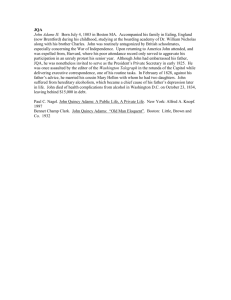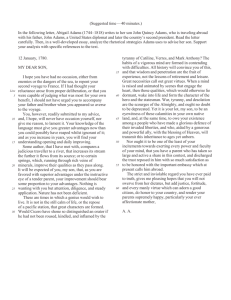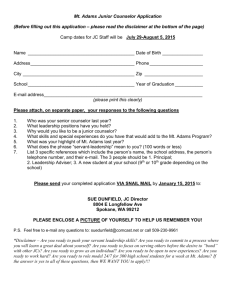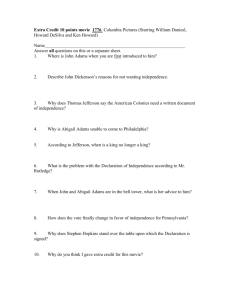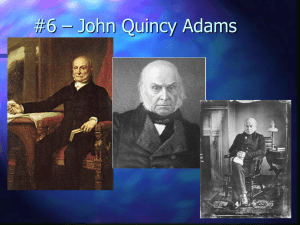Cause and Effect - Field Local Schools
advertisement
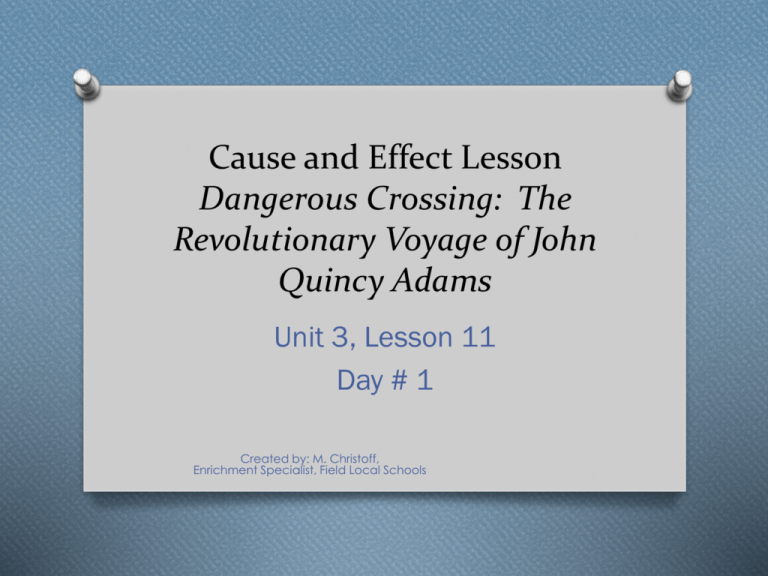
Cause and Effect Lesson Dangerous Crossing: The Revolutionary Voyage of John Quincy Adams Unit 3, Lesson 11 Day # 1 Created by: M. Christoff, Enrichment Specialist, Field Local Schools Objectives for Today • Students will identify cause and effect relationships. • Students will visualize events to identify cause and effect relationships. Cause A cause is an event that makes something else happen. Effect • An Effect is something that happens because of an earlier event. Stated Cause and Effect • The reader can locate the cause and effect relationship stated in the selection. Implied or Inferred Cause and Effect Relationships The reader must utilize clues given by the author to discover the causes and effects in the selection. Why do authors use cause and effect relationships? Authors use causes and effects to structure text to help show relationships between ideas. Visualization • To Visualize is to use details to form pictures in your mind. Young John Quincy Adams (Projectable 11.2) John Quincy Adams grew up during the American Revolution. The battles near his home caused the local school to close. In 1778 and 1780, John went to Europe, Young John Quincy Adams (Projectable 11.2) where he went to French and Dutch schools. Because of this education, he spoke French and Dutch at an early age. In 1781, when John was only 14, he traveled with a U.S. representative to Russia. Young John Quincy Adams (Projectable 11.2) John was the secretary and interpreter. After a year in Russia, John joined his father in Paris. He helped record the information at meetings that led to the end of the Revolutionary War. Think Aloud (Cause and Effect) • I can see that the fighting had more than one effect. The fighting caused John’s school to close, which in turn, caused him to go to school in Europe. Visualizing Causes and Effects • Understanding causes and effects can help readers visualize a story’s events and how they are related, and how those events affect the story’s message or theme. Think Aloud (Visualization) • I can visualize John sadly packing his belongings to leave school, which helps me understand the effect of war on kids. Use an Inference Map to show cause-and-effect relationships. (Projectable 11.2) Cause: John’s school closed due to fighting. Cause: He went to schools in Europe. Effect: He used his language skills to help the government and his father. Cause: He learned to speak French and Dutch. Cause and Effect Lesson Dangerous Crossing: The Revolutionary Voyage of John Quincy Adams Unit 3, Lesson 11 Day # 2 Created by: M. Christoff, Enrichment Specialist, Field Local Schools Objectives for Today • Students will identify cause and effect relationships. • Students will visualize events to identify cause and effect relationships. Cause A cause is an event that makes something else happen. Effect • An Effect is something that happens because of an earlier event. Stated Cause-and-Effect • The reader can locate the cause-and-effect relationship stated in the selection. Implied or Inferred Cause and Effect Relationships The reader must utilize clues given by the author to discover the causes and effects in the selection. They have no signal words because the cause or the effect are not directly stated. Visualization • To Visualize is to use details to form pictures in your mind. The Start of John’s Journey Use an Inference Map to show cause and effect relationships. (Projectable 11.4) Cause: The colonists needed the support of other countries. Cause: The soldiers’ supplies were running low. Effect: John Adams was sent to France. Cause: Other representatives already in Paris were making little progress. Events of Johnny’s Voyage Use an Inference Map to show cause-and-effect relationships. (Projectable 11.4) Cause: One of the British frigates chases and closes in on the Boston. Cause: The Boston encounters three British frigates. Cause: A rough storm hits, and the Boston is struck by lightning. Effect: Johnny and his father experience danger firsthand. Think Aloud (Cause and Effect) • The story doesn’t tell how or why the British ship disappeared, but it does tell about the effects to the Boston that were caused by the terrible storm. These details help me infer the cause of the other ship’s disappearance. When the storm ends, the British frigate is gone and the Boston does not have to fight it. Infer a possible cause of this event. (Page 284-287) Cause: A terrible lightning storm occurs. Cause: The frigate either turns away or sinks during the storm. Cause: The Boston is being chased by a British frigate. Effect: The Boston does not have to fight the British frigate. Questions (Cause and Effect) pp. 281,284, 289 How is the war with England going? • The war is not going well. • What might be on the British merchant ship? • There might be supplies and other valuable goods that the colonists are lacking. • Why do the officers want to catch a British merchant ship? Use an Inference Map to show cause-and-effect relationships. (Page 281, 284, 289) Cause: The colonial army does not have the supplies it needs. Cause: The war with England is not going well. Effect: After the Boston is repaired, it chases down a merchant ship. Cause: The officers think the ships will carry valuable goods. Questions (Cause and Effect) pp. 281, 289, 290 • How does one event in the story lead to the next? How does one event in the story leads to the next? pp. 281, 289, 290 The war started with England. The Americans needed help from other countries. They had to leave in the middle of winter. Their trip was more difficult. John Adams was sent to France to ask for immediate help. What series of cause-and-effect events led John Adams and Johnny to go to Europe? Use your inferring skills to fill in any missing details. (Page 281, 289, 290) Effect: They sent representatives to Paris. Effect: They needed John Adams to convince the Europeans. Cause: The colonists needed help with the war. Effect: John Adams wanted to try to win support for the war. Why do authors use cause and effect relationships? Authors use causes and effects to structure text to help show relationships between ideas.
